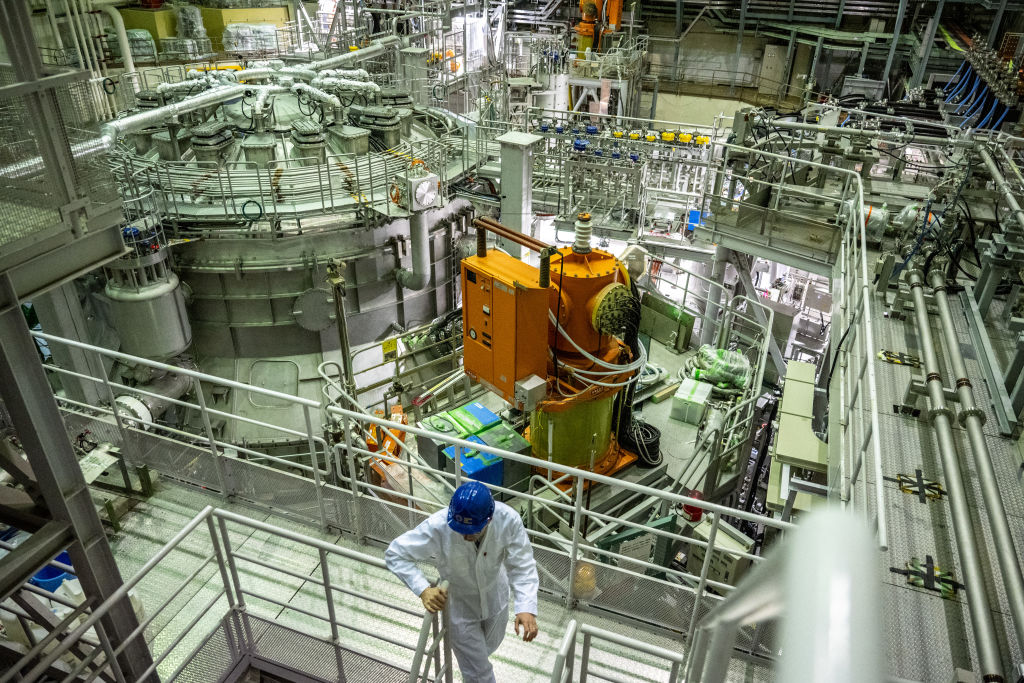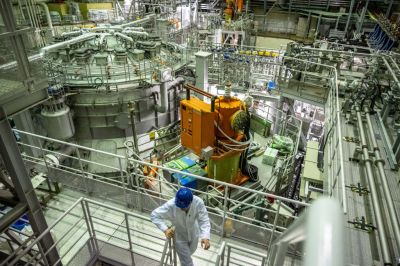Is the promise of nuclear fusion finally coming together?
Considered a nearly inexhaustible power source, nuclear fusion occurs when two lighter atomic nuclei are combined, releasing energy. It’s the same process that produces energy in stars, including the sun. Since our first, very brief successful attempt at fusion, more than 70 years ago, its promise of clean, cheap, and abundant energy has eluded us.
But the low rumble of optimistic reports over the last few years seems to suggest we’re finally getting closer.
Early this month, South Korea’s KFE (Korean Institute of Fusion Energy) announced it had sustained the kind of high temperatures that fusion reactions require—100 million degrees Celsius, seven times hotter than the sun—for 48 seconds, the longest period on record, thanks to an engineering tweak.
The biggest advance in fusion came in late 2022, when researchers at the National Ignition Facility (NIF) at Lawrence Livermore National Laboratory in California achieved the first fusion ignition, getting more energy from a fusion reaction than was directly put into it. NIF went on to repeat fusion ignition three times in 2023, although it also failed in an additional five attempts that year.
This year, using the Joint European Torus facility in Oxford, England, a group of several hundred researchers called EUROfusion produced over 20 times as much energy as NIF’s first ignition just 14 months prior.
These developments come as private commercial firms pursue fusion power alongside national and multinational efforts. The industry’s trade group, the Fusion Industry Association, reported new investment of over $2.8 billion in 2022 alone, according to a December report by NPR. (That number dropped in 2023, mainly because of higher interest rates, according to the same report.)
As with space exploration, where companies built by the fortunes of entrepreneurs such as Jeff Bezos and Elon Musk have partially eclipsed NASA, private fusion companies backed by some of the same people are now firmly in this space. More than a few are promising power on a greatly accelerated timeline compared to the largest fusion effort, ITER (International Thermonuclear Experimental Reactor), a 35-nation collaboration whose management issues and cost overruns have put it seriously behind schedule.
ITER’s original goal of coming online by 2016 has been pushed back to 2025 (at least) and it won’t produce power until more than 10 years after it’s online. Meanwhile, said Kim Budil, director at Lawrence Livermore, “There are companies today that are promising fusion—commercially viable fusion power in the next five to 10 years.” She hopes they succeed, ”but I’m sort of adopting a wait-and-see approach.”
Fusion energy is (almost) forever energy.
Nuclear fusion is the reverse of nuclear fission, which powers the nuclear plants we’re all familiar with. Fission splits atoms of very heavy, unstable isotopes like uranium 235 and captures the released energy. Fusion forces together atoms of very light, stable elements like isotopes of hydrogen, creating slightly heavier elements like helium and producing as much as four times as much energy, per unit of fuel, as fission (and nearly 4 million times as much energy as coal or oil).
Fusion power is viewed as more dependable than wind and solar power; relatively clean, as fossil fuel power is certainly not; and lacking the hazardous waste and uncontrolled reaction risks of nuclear fission. And fusion relies on the abundant element of hydrogen and its isotopes. Fusion’s proponents say it could meet our energy needs for a billion years.
“The physics works,” William Nuttall, a British academic, energy expert, and experimental physicist by training, told The Dispatch. “[We’ve shown] we could bring the energy of the sun to the surface of our planet.”
Why fusion energy is so hard to produce.
But if the science is there, so is the hype.
In “Voodoo Fusion Energy,” a 2018 jeremiad against the claims of some commercial fusion startups, Daniel Jassby, a former research physicist at Princeton Plasma Physics Laboratory, observed that “more than 90% of fusion concepts [had] never produced measurable levels of fusion neutrons, which means those systems probably have no practical value at all.”
While these overhyped companies “will never put electricity onto the grid,” he wrote, “all of them take plenty of energy from the grid.”
That’s harsh, but take one of the more promising fusion energy startups: Helion, which has agreements to produce power for Microsoft and Nucor. NPR reported last year that Helion hoped to “produce electrical output by the end of 2024 and net energy in a matter of years.” While Helion seems to be producing neutrons, it has since moved that output goalpost forward to 2028.
In fairness to Helion and the rest, this is because fusion is really, really hard. The dark joke is that fusion is “the power of the future—and it always will be.” And indeed, it was 70 years from the first successful re-creation of fusion—the detonation of a thermonuclear device codenamed Ivy Mike, in 1952—to NIF’s successful ignition reaction.
It’s so hard, said theoretical astrophysicist and science communicator Ethan Siegel, because “tremendous temperatures and energies” are required to get fusion reactions started and keep them going.
Yes, NIF produced 3.15 million joules of fusion energy–enough to boil 10 teapots of water–with just 2 million joules of laser energy in its watershed 2022 ignition. But applying that laser energy took “about 300 million joules off the U.S. grid,” said Budil. “... We have a long way to go to make an efficient power-producing source.”
Energy-producing fusion reactions will also have to be a lot more powerful. Dennis Whyte, who headed MIT’s Plasma Science and Fusion Center and is now at a commercial spinoff, Commonwealth Fusion Systems, said the NIF ignition had a gain (the ratio of power released to power applied) of about 1.5 but “the gain of a fusion power plant would need to be about 100.”
(For more on the fusion reaction and attempts to harness fusion, check out Lex Fridman’s interview with Whyte, Siegel’s article and Paul M. Sutter’s podcast episode.)
Even if some commercial fusion companies are long on steam and short on neutrons, private sector involvement may be very helpful to developing fusion’s future.
“The wonderful thing about the ecosystem of all this private sector innovation,” said Nuttall, “is [that] people are [working off of] a much wider range of ideas than the public sector was thinking about 20 years ago.”
That experimentation could help solve the many scientific and engineering challenges still facing fusion.
“It’s not entirely certain which talent set” will be required to make fusion commercially viable, said Nuttall. For example, “there’s a lot of cryogenics in magnetic confinement fusion.” But there’s also plasma physics, materials science, computer science, and many other disciplines that go into fusion reactors, he said. “All of these things are relevant.”
And more experimentation will certainly drive the direction of fusion applications. “No one's entirely sure which engineering” remains to be done, said Nuttall. “Whether that will be high-temperature superconductivity, structural materials, cryogenics, or a bit of all three. It’s all in play right now because there are so many concepts being explored now.”
Forget about electricity for a moment.
When it comes to fusion, Nuttall cautions that its applications could be “slightly different than what people expected.”
Fusion simply doesn’t have the reliability that the electrical sector requires. Fission reactors can hum along for 18 months before they’re scheduled to go offline for maintenance. But so far fusion plasmas have been sustained for mere hours. “And energy-generating plasmas have run for seconds,” Nuttall said.
Fusion reactors won’t reliably produce electricity for at least 25 years, he believes. In the meantime, where can fusion get a commercial toehold? Selling the products that fusion is already starting to produce: neutrons and heat.
Fusion creates high-energy neutrons as a by-product. These neutrons are in ever increasing demand by the medical industry, where they’re used to develop diagnostic and therapeutic radioisotopes. Nuttall mentions Shine in the U.S. and Astral Systems in the U.K. as two firms at or near commercial readiness to apply fusion technology to medicine and other industries.
Next, said Nuttall, fusion companies can capture the heat of these high-energy neutrons and sell it—not to electricity plants, but to the oil and gas industry.
The enormous commercial and social pressures to decarbonize are directing the oil and gas industry toward synthetic fuels, which require heat to produce. Fusion companies can deliver that heat more cleanly, further reducing the fossil fuels needed for synfuel production, Nuttall believes. Unlike the electricity sector, the oil and gas industry is used to taking financial and engineering risks, he said, and it has the cash to do so. He points out that the industry is already invested in many of these fusion startups.
While Nuttall admits that while the precise future for fusion energy is difficult to discern, “the landscape exists, and these private sector players are now visibly exploring it. And that’s why it's exciting.” Whyte, who worked for years at ITER before moving to MIT, would agree. “Fusion is really hard, so anything that keeps pushing the needle forward is a good thing,” he said. “But we also have to be realistic about what it means to make a fusion energy system.”
Correction, April 18, 2024: A previous version of this article misstated the first name of Ethan Siegel.






Please note that we at The Dispatch hold ourselves, our work, and our commenters to a higher standard than other places on the internet. We welcome comments that foster genuine debate or discussion—including comments critical of us or our work—but responses that include ad hominem attacks on fellow Dispatch members or are intended to stoke fear and anger may be moderated.
With your membership, you only have the ability to comment on The Morning Dispatch articles. Consider upgrading to join the conversation everywhere.